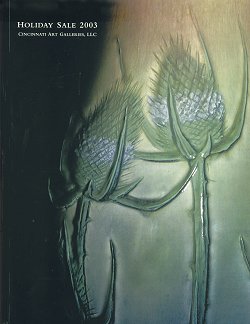Monday, November 03, 2003

The highly selective and appraising eyes of dealers, collectors and scholars within the Art Pottery world were focused upon several 6th Street floors of the Cincinnati Art Galleries this past weekend for their annual Holiday Sale of American and European ceramics, Art Glass and, of course, Rookwood Pottery.
Gallery Director and PBS Antiques Roadshow appraiser, Riley Hummler, in a phone call this morning, said that while prices realized for Rookwood production were “down a little” contrasted against previous years, prices realized for higher quality were, generally, on a par with past sales.
My impression, having attended the last 5 of these, was that sales were strong but not robust.
Another personal impression, confirmed by gleanings from other attendees, was that most buyers felt they had gotten tremendous value for their dollar.
The auction room, on the 5th floor of the CAG’s east side 6th Street facility, was certainly as packed with eager buyers as previous auctions but the general mood seemed, after perhaps a brief exposure to the morning’s news, somewhat somber.
Glib and knowledgeable master auctioneer J. Louis Karp quickly brought the recalcitrant crowd to a semblance of happy purchasing excitement. But, even the ebullient Mr. Karp seemed a bit off his game when an internet snafu briefly interrupted the early moments of the auction and the calm placidity of CAG owners, Michele and Randy Sandler.
When we spoke, Karp, exhausted from a “massive” estate sale looming (including a never before heard of Sea Green glazed fireplace surround featuring relief carved fish), expressed surprised bafflement regarding the Internet.
Family-trained from childhood in fine arts and quality antiques, Karp instinctively hones in to the perceived discernment of a prospective buyer. The Internet, unfortunately to the occupants of a 3 dimensional space including Mr. Karp, seems more an aggressive unsophisticated impulse buyer and resistant to nonweb-based observation.
The CAG’s Internet coordinator told me that for each sale item there were a fluctuating total of around 45 people bidding through Ebay.
The 45 ever-changing Internet strangers, to our poor pre-digital Mr. Karp, and the other room attendees, rapidly mutated into one large cash-flush oaf.
I’m thinking the Ebay-Internet’s buying public, denied the tactility of a showroom perusal is more simpatico with a professional image of a sale item and CAG’s photographer Mark Mussio provided hundreds of sales-inducing images.
.jpg)
Attention-getting sale items included a superb 11” Iris Glaze vase decorated with Goldenrod by Rose Fletcheimer in 1903 sold, in spirited bidding, for $7,250. This was more than $3K over sale estimates.
.jpg)
An unusual and large porcelain by William Hentschel, with a drill hole obscuring some of its marks, hammered for $4,100 or $600 over estimate.
And, a 1902 Limoges-style vase stamped Rookwood and signed with the initials of Mary Louise McLaughlin sold, no doubt thanks to Anita’s Ellis’ new book on McLaughlin, well over its presale estimate high of $2K for $3,400.
The remaining clay pots, as it seemed to my observation, sold a touch below and within estimates.
The star of the weekend was the massive example of Rookwood’s rare and academically controversial Flowing Glaze line that graced the catalogue cover.
The striking vessel with its relief carved Teasel decoration hit this year’s high by hammering for $21,000, a figure lower than my recollection of previous records that sold in the mid $30 and $40K range.
According to the catalogue:
Flowing Glaze was briefly mentioned by Rookwood in 1902 and examples are listed twice in Burt (Stanley G., Rookwood’s chemist and superintendent) in 1901…all examples have been derivative of Iris glaze, i.e. a clear high glaze that seems to mingle (flow?) with the background colors…markings on this vase…the Rookwood logo and date, special shape number S1703 A, an incised W for White (Iris) glaze, an incised F, possibly for Flowing glaze and the incised full signature of the artist, Matt Daley. Also on the bottom is a serrated round label, which reads “Not For Sale”.
While a great deal is known about the Rookwood Pottery, Stanley G. Burt’s clay formulations and glaze experiments, transcribed by Karl Langenbeck, remain lost to history.
Since mixtures of 5 or more clays were required for most ceramic vessels (except Yellow clay for a brief time), the clays have proved less susceptible to scholarship than the glaze lines.
The most successful modern classification of Rookwood pottery has been Anita Ellis’ Rookwood: The Glaze Lines.
This modern classification has been a great help to collector’s and dealers alike.
Ellis and the CAG are to be complimented for their envelope-pushing scholarship!
Ellis, the Cincinnati Art Museum’s Director of Curatorial Affairs, was present at Sunday’s event and perhaps, also, noted the undescribed unique qualities of the clay under the above-mentioned Flowing Glaze.
I did notice her look of happy surprise when the example of McLaughlin’s Cincinnati Faience hit $1,400 over estimate!
Copies of the Holiday Sale 2003 can be purchased from the CAG.
Reference: The Book of Rookwood Pottery Vol. 1
Photos: from the Holiday '03 sale catalogue


